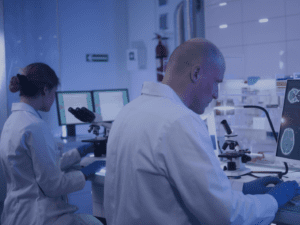RCH Achieves AWS Life Sciences Competency
Leading Cloud solutions exclusively for Life Sciences teams that accelerate discovery, optimize costs and ensure scalability and compliance in AWS.
Design of Experiments (DOE) is one of the most essential tools scientists can use to accelerate timelines, optimize costs, maximize insights, and minimize risks when making informed decisions. For example, clinical trials employ a variety of experimental designs to determine whether a new medicine effectively improves patients’ lives and to what extent.
If you are developing therapies with the goal of entering human clinical trials, the expertise of statisticians in the field of Experimental Design is indispensable. Regulatory agencies require a thorough understanding of the study’s structure: the number of patients involved, how outcomes are measured, the statistical power necessary to detect a significant effect, and the methods you plan to use for data analysis and reporting. To meet these demands, BioPharma companies must engage a clinical statistics CRO or build an in-house clinical team that includes statisticians, programmers, operations specialists, and data managers. Although these teams may begin small, as trials progress, organizational needs and staffing often scale quickly.
So, why do agencies invest so much time to ensure these plans are robust? As we know, health authorities have a mandate to ensure that medicines are both safe and effective. The public relies on these agencies to minimize risks, guarantee the quality of medicines, and confirm their efficacy for intended uses.
If this level of statistical rigor is required for clinical trials, why don’t more companies prioritize a similar approach with non-clinical statistics? The current economic climate in BioPharma might provide some insight. In 2024 alone, more than 140 layoff announcements have led to a substantial reduction in the workforce, putting pressure on companies to prioritize short-term savings over long-term gains. With a focus on cost-cutting, roles or functions, like non-clinical statisticians, that may be perceived as optional, are often the first to be scaled back or excluded.
However, consider the benefits of applying non-clinical statistical expertise from the early stages of development.
How can we leverage this expertise from the very beginning of the product lifecycle?
How can we design experimental plans that seamlessly guide us through process development, characterization, analytical validation, tech transfer, and, ultimately, commercialization?
By starting with a clear understanding of our desired outcomes, it’s possible to maximize resource efficiency and avoid costly missteps throughout R&D.
Non-clinical statistics can significantly streamline the development process. With a well-executed preclinical statistical plan, companies can craft an IND package that stands up to regulatory scrutiny, reduce the volume of experiments needed for complete process or method qualification for the BLA, and create a robust narrative that supports product development history, specification setting, and process comparability designs. What do all these benefits have in common? They reflect not an ‘extra’ but a strategic investment in efficiency that can smooth and accelerate medicine development.
Engaging non-clinical statisticians, much like clinical statisticians, is crucial to the success of your BioPharma organization. Leveraging tools such as Design of Experiments not only brings rigor to research and development, but also contributes to substantial savings in time, resources, and inefficiency. In today’s competitive and cost-conscious BioPharma landscape, employing non-clinical statistics is a forward-thinking, yet critical approach, that ensures every development dollar is spent effectively, bringing high-quality treatments to patients sooner.
Learn more about how RCH Solutions can support your non-clinical statistical efforts with the expertise of industry veterans, including seasoned non-clinical statisticians like JoAnn Coleman.
Driving Success from Discovery to Commercialization
Throughout the BioPharma industry, many think statistics are critical only to human clinical trials. However, Non-Clinical Statistics plays a pivotal role in moving assets through discovery, research, and development—all the way to commercialization. Though lesser known, these specialized statisticians are essential to ensuring that every aspect of a drug’s journey from lab bench to market is grounded in rigorous, data-driven decision-making.
The Power of Non-Clinical Statistics
At RCH Solutions, there is a keen awareness that drug development is a complex, high-stakes process. Success rates hover around 7-8%1, and setbacks in the early development or manufacturing stages can result in costly delays. A skilled non-clinical statistician can distinguish between a program that stalls and moves forward confidently. Non-clinical statisticians specialize in addressing challenges that arise long before clinical trials begin. They support diverse teams across Discovery, Research, and Chemistry, Manufacturing, and Controls (CMC), ensuring your program is designed to answer the right questions from the outset.
Early-Stage Impact: Target Identification and Method Development
Designing the suitable experiments in the early stages of drug discovery is critical. Non-clinical statisticians help BioPharma organizations by guiding the setup of studies that provide reliable, actionable data. Whether designing NGS studies to identify targets or working with chemists to optimize analytical methods, non-clinical statisticians help ensure that your data answers the questions that matter.
With proper statistical guidance, teams could save time and resources by quantifying value and avoiding chasing the wrong or inconclusive outcomes. A non-clinical statistician helps to mitigate this risk, maximizing the value of your early-stage research and putting you on the path to success.
Optimizing Manufacturing Processes and Ensuring Quality
Regarding manufacturing, non-clinical statisticians are critical players in developing robust process understanding and product characterization. They collaborate with engineers and chemists to design experiments that optimize processes, minimize variation, and consistently produce high-quality products.
Statistical methods can also be applied to issues like impurity reduction, process transfer to Contract Manufacturing Organizations (CMOs), or method validation—tasks vital to smooth regulatory submission and approval. In this way, Non-Clinical Statistics mitigate risk and keep the drug development pipeline moving forward.
Bridging the Gap Between Science and Regulation
Regulatory submissions can be a significant hurdle in getting a product to market. A well-designed statistical plan can help address concerns from agencies regarding impurities, method validation, or product stability. Non-clinical statisticians, equipped with the ability to model complex scenarios and collaborate with scientific teams, play a critical role in ensuring the readiness of an asset for regulatory approval.
Their expertise enables your team to present data compellingly and scientifically soundly, meeting the rigorous expectations of regulatory bodies. From INDs to BLAs and NDAs, they ensure your program’s foundation is built on solid, data-driven decisions.
Partnering with RCH Solutions: The Non-Clinical Statistics Advantage
At RCH Solutions, we understand Non-Clinical Statistics critical role in BioPharma’s success. Our team of expert statisticians works collaboratively with your R&D and CMC teams to ensure programs are designed for optimal outcomes, not bottlenecks. From target selection to regulatory approval, we deliver data-driven insights that save time and resources, minimizing trial and error. By leveraging our expertise, you can streamline processes, enhance production, and confidently move your drug development program forward—ultimately bringing life-changing medicines to patients faster.
Get in touch with our team of expert statisticians today to learn more about our Non-Clinical Statistics services.
1 Source: Biotechnology Innovation Organization (BIO), Informa, QLS Advisors, Clinical Development Success Rates 2011-2020.
Cloud technologies remain a highly cost-effective solution for computing. In the early days, these technologies signaled the end of on-premise hardware, floor space and potentially staff. Now, the focus has shifted to properly optimizing the Cloud environment to continue reaping the cost benefits. This is particularly the case for Biotech and Pharma companies that require a great deal of computing power to streamline drug discovery and research.
 Managing costs related to your computing environment is critical for emerging Biotechs and Pharmas. As more data is collected, new compliance requirements emerge, and novel drugs are discovered and move into the next stages of development, your dependence on the Cloud will grow accordingly. It’s important to consider cost optimization strategies now and keep expenses under control. Optimizing your Cloud environment with the right tools, options, and scripts will help you get the most value and allow you to grow uninhibited.
Managing costs related to your computing environment is critical for emerging Biotechs and Pharmas. As more data is collected, new compliance requirements emerge, and novel drugs are discovered and move into the next stages of development, your dependence on the Cloud will grow accordingly. It’s important to consider cost optimization strategies now and keep expenses under control. Optimizing your Cloud environment with the right tools, options, and scripts will help you get the most value and allow you to grow uninhibited.
Let’s explore some top cost containment tips that emerging Biotech and Pharma startups can implement.
No one wants to pay for more than they need. However, when you’re an emerging company, your computing needs are likely to evolve quickly as you grow.
This is where it helps to understand instance types and apply them to specific workloads and use cases. For example, using a smaller instance type for development and testing environments can save costs compared to using larger instances meant for production workloads.
Spot instances are spare compute capacity offered by Cloud providers at a significant discount compared to on-demand instances. You can use these instances for workloads that can tolerate interruptions or for non-critical applications to save costs.
Another option is to choose an auto-scaling approach that will allow you to automatically adjust your computing based on the workload. This reduces costs by only paying for what you use and ensuring you don’t over-provision resources.
Guardrails are policies or rules companies can implement to optimize their Cloud computing environment. Examples of guardrails include:
Working with solutions like AWS Control Tower or Turbot can help you set up these cost control guardrails and stick to a budget. Ask the provider what cost control options they offer, such as budgeting tools or usage tracking. From there, you can collaborate on an effective cost optimization strategy that aligns with your business goals. Your vendor may also work with you to implement these cost management strategies, as well as check in with you periodically to see what’s working and what needs to be adjusted.
 Similar to electronics consuming power when plugged in but not in use, your computing environment can suck up costs and resources even during downtime. One way to mitigate usage and save on costs is to create custom scripts that automatically turn off computing resources when not in use.
Similar to electronics consuming power when plugged in but not in use, your computing environment can suck up costs and resources even during downtime. One way to mitigate usage and save on costs is to create custom scripts that automatically turn off computing resources when not in use.
To start, identify which resources can be turned off (e.g., databases, storage resources). From there, you can review usage patterns and create a schedule for turning off those resources, such as after-hours or on weekends.
Scripting languages such as Python or Bash can create scripts that will turn off these resources according to your strategy. Once implemented, test the scripts to ensure they’re correct and will produce the expected cost savings.
Many vendors, including market-leader AWS, offer special programs to help new customers get acclimated to the Cloud environment. For instance, AWS Jumpstart helps customers accelerate their Cloud adoption journey by providing assistance and best practices. Workshops, quick-start help, and professional services are part of the program. They also offer funding and credits to help customers start using AWS in the form of free usage tiers, grants for nonprofit organizations, and funding for startups.
Other vendors may offer similar programs. It never hurts to ask what’s available.
Fast-tracking toward the Cloud starts with great relationships. Working with an established IT company like RCH that specializes in Biotechs and Pharmas and also has established relationships with Cloud providers, including as a Select Consulting Partner with AWS, as well as associated technologies gives you the best of both worlds.
Cloud cost optimization strategies shouldn’t be treated as an afterthought or put off until you start growing.
![]() It’s best practice to instill cost control guardrails now and think about how you can scale your Cloud computing in the future so that cost doesn’t become a growth inhibitor.
It’s best practice to instill cost control guardrails now and think about how you can scale your Cloud computing in the future so that cost doesn’t become a growth inhibitor. ![]()
In an industry that moves at the speed of technology, RCH Solutions brings a wealth of specialized expertise to help you thrive. We apply our experience in working with BioPharma companies and startups to ensure your budget, computing capacity, and business goals align.
We invite you to schedule a one-hour complimentary consultation with SA on Demand, available through the AWS Marketplace, to learn more about cost optimization strategies in the Cloud and how they support your business. Together, we can develop a Cloud computing environment that balances the best worlds of budget and breakthroughs.
https://docs.aws.amazon.com/AWSEC2/latest/UserGuide/instance-types.html
Life Sciences organizations engaged in drug discovery, development, and commercialization grapple with intricate challenges. The quest for novel therapeutics demands extensive research, vast datasets, and the integration of multifaceted processes. Managing and analyzing this wealth of data, ensuring compliance with stringent regulations, and streamlining collaboration across global teams are hurdles that demand innovative solutions.
Moreover, the timeline from initial discovery to commercialization is often lengthy, consuming precious time and resources. To overcome these challenges and stay competitive, Life Sciences organizations must harness cutting-edge technologies, optimize data workflows, and maintain compliance without compromise.
Amid these complexities, Amazon Web Services (AWS) emerges as a game-changing ally. AWS’s industry-leading cloud platform includes specialized services tailored to the unique needs of Life Sciences and empowers organizations to:
While AWS holds immense potential, realizing its benefits requires expertise. This is where a trusted AWS partner becomes invaluable. An experienced partner not only understands the intricacies of AWS but also comprehends the unique challenges Life Sciences organizations face.
Certified AWS engineers bring transformative expertise to cloud strategy and data architecture, propelling organizations toward unprecedented success.
AWS offers a comprehensive suite of globally recognized certifications, each representing a distinct level of proficiency in managing AWS Cloud technologies. These certifications are not just badges; they signify a commitment to excellence and a deep understanding of Cloud infrastructure.
In fact, studies show that professionals who pursue AWS certification are faster, more productive troubleshooters than non-certified employees. For research and development IT teams, the AWS certifications held by their members translate into powerful advantages. These certifications unlock the ability to harness AWS’s cloud capabilities for driving innovation, efficiency, and cost-effectiveness in data-driven processes.
At RCH, we’re proud to prioritize professional and technical skill development across our team, and proudly recognize our AWS-certified professionals:
When you partner with RCH and our AWS-certified experts, you gain access to technical knowledge and tap into a wealth of experience, innovation, and problem-solving capabilities. Advanced proficiency in AWS certifications means that our team can tackle even the most complex Cloud challenges with confidence and precision.
Our certified AWS experts don’t just deploy Cloud solutions; they architect them with your unique business needs in mind. They optimize for efficiency, scalability, and cost-effectiveness, ensuring your Cloud strategy aligns seamlessly with your organizational goals, including many of the following needs:
All of these tasks have boosted the efficiency of data-oriented processes for clients and made them better able to capitalize on new technologies and workflows.
In an era where data and technology are the cornerstones of success, working with a partner who embodies advanced proficiency in AWS is not just a strategic choice—it’s a game-changing move. At RCH Solutions, we leverage the power of AWS certifications to propel your organization toward unparalleled success in the cloud landscape.
Learn how RCH can support your Cloud strategy, or CloudOps needs today.
 Finding the right Bio-IT partner to navigate the complex landscape that is science-IT is no easy task. With a multitude of factors to consider (such as expertise, outcomes, scalability, data security, and adherence to industry regulations), evaluating potential partners can be an overwhelming process. That’s where a Bio-IT scorecard approach comes in handy.
Finding the right Bio-IT partner to navigate the complex landscape that is science-IT is no easy task. With a multitude of factors to consider (such as expertise, outcomes, scalability, data security, and adherence to industry regulations), evaluating potential partners can be an overwhelming process. That’s where a Bio-IT scorecard approach comes in handy.
By using a structured evaluation approach, organizations can focus on what truly matters—aligning their organizational requirements with the capabilities and expertise of potential Bio-IT partners. Not the other way around. Here’s how using a scorecard can help streamline decision-making and ensure successful collaborations.
Every Biopharma is on a mission, whether it’s to develop and deliver new, life-changing therapeutics, or advance science to drive innovation and change. While they share multiple common needs, such as the ability to process large and complex datasets, the way in which each organization uses IT and technology can vary.
Biopharma companies must assess how well their current or potential Bio-IT partner’s services align with the organization’s unique computing needs, such as data analysis, HPC, cloud migration, or specialized software support. And that’s where a Bio-IT scorecard can be helpful. For example, a company with multiple locations must enable easy, streamlined data sharing between facilities while ensuring security and authorized-only access. A single location may also benefit from user-based privileges, but their needs and processes will vary since users are under the same roof.
Organizations must also evaluate the partner’s proficiency in addressing specific Bio-IT challenges relevant to their operations by asking questions such as:
Questions like these on your own Bio-IT scorecard can help your organization better understand a potential partner’s proficiency in areas specific to your needs and objectives. And this ultimately helps your team understand if the partner is capable of helping prepare your firm scale by reducing bottlenecks and clearing a path to discovery.
 Organizations can rate their shortlist partners on relevant technologies, platforms, and scientific computing to learn more about technical proficiency. It’s equally important to apply proficiency to the unique needs of Biopharmas.
Organizations can rate their shortlist partners on relevant technologies, platforms, and scientific computing to learn more about technical proficiency. It’s equally important to apply proficiency to the unique needs of Biopharmas.
According to a industry survey, respondents agree that IT and digital innovation are needed to solve fundamental challenges that span the entire spectrum of operations, including “dedicated funding (59%), a better digital innovation strategy (49%), and the right talent (47%) to scale digital innovation.” It’s essential that IT partners can connect solutions to these and other business needs to ensure organizations are poised for growth.
It’s also critical to verify the partner’s track record of delivering Bio-IT services to organizations within the Life Sciences industry specifically. And the associated outcomes they’ve achieved for similar organizations. To do this, organizations can obtain references and ask specific questions about technical expertise, such as:
Successful IT partners are those who can speak from a place of authority in both science and IT. This means being able to understand the technical aspect as well as applying that technology to the nuances of companies conducting pre-clinical and clinical R&D. While IT companies are highly skilled in the former, very few are specialized enough to also embrace the latter. It’s essential to work with a specialized partner that understands this niche segment – the Life Sciences industry. And creating a Bio-IT scorecard based on your unique needs can help you do that.
IT companies make it their goal to provide optimal solutions to their clients. However, they must also absorb their clients’ goals as their own to ensure they’re creating and delivering the technology needed to drive breakthroughs and accelerate discovery and time-to-value.
Assess how well the partner’s capabilities and services align with your specific research objectives and requirements by asking:
The more experience in servicing research areas that are similar to yours, the less guesswork involved and the faster they can implement optimal solutions.
In the rapidly evolving field of Life Sciences, data generation rates are skyrocketing, making scalability and extensibility vital for future growth. Each project may require unique analysis pipelines, tools, and integrations with external software or databases. A Bio-IT partner should be able to customize its solutions based on individual requirements and handle ever-increasing volumes of data efficiently without compromising performance. To help uncover their ability to do that, your team might consider:
By choosing a Bio-IT partner that prioritizes flexibility and scalability, organizations can future-proof their research infrastructure from inception. They can easily scale up resources as their data grows exponentially while also adapting to changing scientific objectives seamlessly. This agility allows scientists to focus more on cutting-edge research rather than getting bogged down in technical bottlenecks or outdated systems. The potential for groundbreaking discoveries in healthcare and biotechnology becomes even more attainable.
In an industry governed by strict regulations such as HIPAA (Health Insurance Portability and Accountability Act) and GDPR (General Data Protection Regulation), partnering with a Bio-IT company that is fully compliant with these regulations is essential. Compliance ensures that patient privacy rights are respected, data is handled ethically, and legal implications are avoided.
As part of your due diligence, you should consider the following as it relates to a potential partner’s approach to data security and regulatory compliance:
A strong partnership relies on open lines of communication, where both parties can share and leverage their subject matter expertise in order to work towards a common goal. Look for partners who have experience working with diverse and cross-functional teams, and have successfully integrated technology into various workflows.
Evaluate the partner’s communication channels, responsiveness, and willingness to collaborate effectively with the organization’s IT team and other important stakeholders. Consider their approach to project management, reporting, and transparent communication, and how it aligns with your internal processes and preferences.
The value of developing and using a Bio-IT scorecard to ensure a strong alignment between the organization’s Bio-IT needs and the right vendor fit cannot be overstated. Using a scorecard model gives you a holistic, systematic, objective way to evaluate potential or current partners to ensure your needs are being met—and expectations hopefully exceeded.
Biotechs and Pharmas can benefit greatly from specialized Bio-IT partners like RCH Solutions. With more than 30 years of exclusive focus servicing the Life Sciences industry, organizations can gain optimal IT solutions that align with business objectives and position outcomes for today’s needs and tomorrow’s challenges. Learn more about what RCH Solutions offers and how we can transform your Bio-IT environment.
https://www.genome.gov/genetics-glossary/Bioinformatics
In today’s fast-paced and rapidly evolving world of Life Sciences, successful organizations know innovation is the key to success. But game-changing innovation without effective collaboration is not possible.
Think about it. Bringing together diverse minds, specialized skill sets, and unique perspectives is crucial for making breakthroughs in scientific research, data analysis, and clinical advancements. It’s like the X-factor that can unlock new discoveries, achieve remarkable results, and fast-track time-to-value.
In leading RCH and working with dozens of different teams across the Life Sciences space, I’ve seen what works—some things better than others—within organizations looking to foster a greater sense of collaboration to drive innovation.
One of the critical advantages of collaboration in the Life Sciences is the ability to leverage diverse perspectives and expertise. But traditionally, many organizations have functioned within siloed structures, with each department working independently towards their goals. However, this approach often leads to fragmented progress, limited knowledge sharing, and missed opportunities. By embracing cross-functional collaboration, Life Sciences organizations can break down these barriers and foster an environment that encourages the free flow of ideas, expertise, and resources. As the saying goes, “Two heads are better than one,” which is all the more true in the case of collaboration—the potential for breakthrough solutions expands exponentially.
By collaborating with specialized service providers, organizations can leverage their expertise and extend to a broader ecosystem to help streamline processes, implement robust data management strategies, and ensure compliance with regulatory requirements. Such partnerships bring fresh perspectives, complementary expertise and can help drive efficiencies, by leveraging specialized resources, experience and expertise. This ultimately allows Life Sciences companies to focus on their core competencies—research and science.
Life Sciences is a multidisciplinary field that requires expertise in biology, research and development, information technology, data analysis, and more. Creating cross-functional teams that bring together individuals with diverse backgrounds can foster creativity and innovation through the pooling of data, the sharing of insights, and the generation of new hypotheses—ultimately leading to faster insights and more meaningful outcomes. When scientists, data analysts, bioinformaticians, software developers, and domain experts collaborate, they can collectively develop novel solutions, generate new insights, and optimize processes—more efficiently.
Collaboration and the power of strategic partnerships allows Life Sciences organizations to tackle complex problems—and opportunities—from multiple angles. By leveraging the collective intelligence of cross-functional teams, and external specialists, organizations can tap into a wealth of knowledge and experience. This enables them to analyze challenges from different perspectives, identify potential blind spots, and develop comprehensive solutions. The synergy created by collaboration often leads to breakthrough discoveries and more efficient problem-solving.
As we all know, technology is constantly evolving, and keeping pace with the latest advancements can be a daunting task. Collaborating with the right Bio-IT partner helps Life Sciences organizations remain at the forefront of innovation. By fostering partnerships with R&D IT experts, organizations gain access to cutting-edge tools, methodologies, and insights, enabling them to adopt new technologies swiftly and effectively. The ideal Bio-IT partner also has a deep understanding of the complete life cycle of the Cloud journey, for both enterprise and emerging Biopharmas, and from inception to optimization and beyond, enabling them to provide tailored and specialized support at any stage of their distinct Cloud journey. This ultimately assists them in attaining their individual discovery goals and again, allows scientists the bandwidth to focus on their core competencies—research, science and discovery.
In the world of Life Sciences, I truly believe that collaboration, both internally through cross-functional teams, and externally through strategic partnerships, is the key to unlocking transformative breakthroughs. And organizations that aren’t focused on creating and sustaining a collaborative culture or cross-functional strategy? They’ll get left behind.
By harnessing collaboration, organizations can tap into a wealth of knowledge that can drive innovation, enhance problem-solving capabilities, and adapt to rapid technological advances. Embracing collaboration not only accelerates progress but also cultivates a culture of continuous learning and excellence. And the latter is the type of organization that top talent will flock to and thrive within.
As a leading Bio-IT organization, the team at RCH Solutions believes that it is essential to prioritize collaboration, foster meaningful partnerships, and nurture cross-functional teams to shape the future of the Life Sciences industry. Why? Because we’ve seen the accelerative power it brings—driving breakthroughs, accelerating discovery and smashing outcomes—time and time again.
Data pipelines are simple to understand: they’re systems or channels that allow data to flow from one point to another in a structured manner. But structuring them for complex use cases in the field of genomics is anything but simple.
Genomics relies heavily on data pipelines to process and analyze large volumes of genomic data efficiently and accurately. Given the vast amount of details involving DNA and RNA sequencing, researchers require robust genomics pipelines that can process, analyze, store, and retrieve data on demand.
It’s essential to build genomics pipelines that serve the various functions of genomics research and optimize them to conduct accurate and efficient research faster than the competition. Here’s how RCH is helping your competitors implement and optimize their genomics data pipelines, along with some best practices to keep in mind throughout the process.
Whether you’re creating a new data pipeline for your start-up or streamlining existing data processes, your entire organization will benefit from laying a few key pieces of groundwork first. These decisions will influence all other decisions you make regarding hosting, storage, hardware, software, and a myriad of other details.
Defining the problem and data requirements
All data-driven organizations, and especially the Life Sciences, need the ability to move data and turn them into actionable insights as quickly as possible. For organizations with legacy infrastructures, defining the problems is a little easier since you have more insight into your needs. For startups, a “problem” might not exist, but a need certainly does. You have goals for business growth and the transformation of society at large, starting with one analysis at a time. So, start by reviewing your projects and goals with the following questions:
Leaning into your projects and goals and the outcomes of the above questions in the planning phase will lead to an architecture that will be laid out to deliver the most efficient results based on how you work. The answers to the above questions (and others) will also reveal more about your data requirements, including storage capacity and processing power, so your team can make informed and sustainable decisions.
Data collection and storage
The Cloud has revolutionized the way Life Sciences companies collect and store data. AWS Cloud computing creates scalable solutions, allowing companies to add or remove space as business dictates. Many companies still use on-premise servers, while others are using a hybrid mix.
Part of the decision-making process may involve compliance with HIPAA, GDPR, the Genetics Diagnostics Act, and other data privacy laws. Some regulations may prohibit the use of public Cloud computing. Decision-makers will need to consider every angle, every pro, and every con to each solution to ensure efficiency without sacrificing compliance.
Data cleaning and preprocessing
 Raw sequencing data often contains noise, errors, and artifacts that need to be corrected before downstream analysis. Pre-processing involves tasks like trimming, quality filtering, and error correction to enhance data quality. This helps maintain the integrity of the pipeline while improving outputs.
Raw sequencing data often contains noise, errors, and artifacts that need to be corrected before downstream analysis. Pre-processing involves tasks like trimming, quality filtering, and error correction to enhance data quality. This helps maintain the integrity of the pipeline while improving outputs.
Data movement
Generated data typically writes to local storage and is then moved elsewhere, such as the Cloud or network-attached storage (NAS). This gives companies more capacity, plus it’s cheaper. It also frees up local storage for instruments which is usually limited.
The timeframe when the data gets moved should also be considered. For example, does the data get moved at the end of a run or as the data is generated? Do only successful runs get moved? The data format can also change. For example, the file format required for downstream analyses may require transformation prior to ingestion and analysis. Typically, raw data is read-only and retained. Future analyses (any transformations or changes) would be performed on a copy of that data.
Data disposal
What happens to unsuccessful run data? Where does the data go? Will you get an alert? Not all data needs to be retained, but you’ll need to specify what happens to data that doesn’t successfully complete its run.
Organizations should also consider upkeep and administration. Someone should be in charge of responding to failed data runs as well as figuring out what may have gone wrong. Some options include adding a system response, isolating the “bad” data to avoid bottlenecks, logging the alerts, and identifying and fixing root causes.
Data analysis and visualization
Visualizations can help speed up analysis and insights. Users can gain clear-cut answers from data charts and other visual elements and take decisive action faster than reading reports. Define what these visuals should look like and the data they should contain.
Location for the compute
Where the compute is located for cleaning, preprocessing, downstream analysis, and visualization is also important. The closer the data is to the computing source, the shorter distance it has to travel, which translates into faster data processing.
Establishing a scalable architecture is just the start. As technology improves and evolves, opportunities to optimize your genomic data pipeline become available. Some of the optimization techniques we apply include: 
Parallel processing and distributed computing
Parallel processing involves breaking down a large task into smaller sub-tasks which can happen simultaneously on different processors or cores within a single computer system. The workload is divided into independent parts, allowing for faster computation times and increased productivity.
Distributed computing is similar, but involves breaking down a large task into smaller sub-tasks that are executed across multiple computer systems connected to one another via a network. This allows for more efficient use of resources by dividing the workload among several computers.
Cloud computing and serverless architectures
Cloud computing uses remote servers hosted on the internet to store, manage, and process data instead of relying on local servers or personal computers. A form of this is serverless architecture, which allows developers to build and run applications without having to manage infrastructure or resources.
Containerization and orchestration tools
Containerization is the process of packaging an application, along with its dependencies and configuration files, into a lightweight “container” that can easily deploy across different environments. It abstracts away infrastructure details and provides consistency across different platforms.
Containerization also helps with reproducibility. Users can expect better performance if the computer is in close proximity to the data. It can also be optimized for longer-term data retention by moving data to a cheaper storage area when feasible.
Orchestration tools manage and automate the deployment, scaling, and monitoring of containerized applications. These tools provide a centralized interface for managing clusters of containers running on multiple hosts or cloud providers. They offer features like load balancing, auto-scaling, service discovery, health checks, and rolling updates to ensure high availability and reliability.
Caching and data storage optimization
We explore a variety of data optimization techniques, including compression, deduplication, and tiered storage, to speed up retrieval and processing. Caching also enables faster retrieval of data that is frequently used. It’s readily available in the cache memory instead of being pulled from the original source. This reduces response times and minimizes resource usage.
As genomics research becomes increasingly complex and capable of processing more and different types of data, it is essential to manage and optimize the data pipeline efficiently to create accurate and reproducible results. Here are some best practices for data pipeline management in genomics.
About 1 in 10 people (or 30 million) in the United States suffer from a rare disease, and in many cases, only special analyses can detect them and give patients the definitive answers they seek. These factors underscore the importance of genomics and the need to further streamline processes that can lead to significant breakthroughs and accelerated discovery.
But implementing and optimizing data pipelines in genomics research shouldn’t be treated as an afterthought. Working with a reputable Bio-IT provider that specializes in the complexities of Life Sciences gives Biopharmas the best path forward and can help build and manage a sound and extensible scientific computing environment, that supports your goals and objectives, now and into the future. RCH Solutions understands the unique requirements of data processing in the context of genomics and how to implement data pipelines today while optimizing them for future developments.
Let’s move humanity forward together — get in touch with our team today.
Sources
https://www.ncbi.nlm.nih.gov/pmc/articles/PMC5580401/
https://www.seagate.com/blog/what-is-nas-master-ti/
https://greatexpectations.io/blog/data-tests-failed-now-what
Life sciences organizations process more data than the average company—and need to do so as quickly as possible. As the world becomes more digital, technology has given rise to two popular computing models: Cloud computing and edge computing. Both of these technologies have their unique strengths and weaknesses, and understanding the difference between them is crucial for optimizing your science IT infrastructure now and into the future. 
Cloud computing refers to a model of delivering on-demand computing resources over the internet. The Cloud allows users to access data, applications, and services from anywhere in the world without expensive hardware or software investments.
Edge computing, on the other hand, involves processing data at or near its source instead of sending it back to a centralized location, such as a Cloud server.
Now, let’s explore the differences between Cloud vs. edge computing as they apply to Life Sciences and how to use these learnings to formulate and better inform your computing strategy.
One of the major advantages of edge computing over Cloud computing is speed. With edge computing, data processing occurs locally on devices rather than being sent to remote servers for processing. This reduces latency issues significantly, as data doesn’t have to travel back and forth between devices and Cloud servers. The time taken to analyze critical data is quicker with edge computing since it occurs at or near its source without having to wait for it to be transmitted over distances. This can be critical in applications like real-time monitoring, autonomous vehicles, or robotics.
Cloud computing, on the other hand, offers greater processing power and scalability, which can be beneficial for large-scale data analysis and processing. By providing on-demand access to shared resources, Cloud computing offers organizations greater processing power, scalability, and flexibility to run their applications and services. Cloud platforms offer virtually unlimited storage space and processing capabilities that can be easily scaled up or down based on demand. Businesses can run complex applications with high computing requirements without having to invest in expensive hardware or infrastructure. Also worth noting is that Cloud providers offer a range of tools and services for managing data storage, security, and analytics at scale—something edge devices cannot match.
With edge computing, there could be a greater risk of data loss if damage were to occur to local servers. Data loss is naturally less of a threat with Cloud storage, but there is a greater possibility of cybersecurity threats in the Cloud. Cloud computing is also under heavier scrutiny when it comes to collecting personal identifying information, such as patient data from clinical trials.
A top priority for security in both edge and Cloud computing is to protect sensitive information from unauthorized access or disclosure. One way to do this is to implement strong encryption techniques that ensure data is only accessible by authorized users. Role-based permissions and multi-factor authentication create strict access control measures, plus they can help achieve compliance with relevant regulations, such as GDPR or HIPAA.
Organizations should carefully consider their specific use cases and implement appropriate security and privacy controls, regardless of their elected computing strategy.
Scalability and flexibility are both critical considerations in relation to an organization’s short and long-term discovery goals and objectives.
The scalability of Cloud computing has been well documented. Data capacity can easily be scaled up or down on demand, depending on business needs. Organizations can quickly scale horizontally too, as adding new devices or resources as you grow takes very little configuration and leverages existing Cloud capacities.
 While edge devices are becoming increasingly powerful, they still have limitations in terms of memory and processing power. Certain applications may struggle to run efficiently on edge devices, particularly those that require complex algorithms or high-speed data transfer.
While edge devices are becoming increasingly powerful, they still have limitations in terms of memory and processing power. Certain applications may struggle to run efficiently on edge devices, particularly those that require complex algorithms or high-speed data transfer.
Another challenge with scaling up edge computing is ensuring efficient communication between devices. As more and more devices are added to an edge network, it becomes increasingly difficult to manage traffic flow and ensure that each device receives the information it needs in a timely manner.
Both edge and Cloud computing have unique cost management challenges—and opportunities— that require different approaches.
Edge computing can be cost-effective, particularly for environments where high-speed internet is unreliable or unavailable. Edge computing cost management requires careful planning and optimization of resources, including hardware, software, device and network maintenance, and network connectivity.
In general, it’s less expensive to set up a Cloud-based environment, especially for firms with multiple offices or locations. This way, all locations can share the same resources instead of setting up individual on-premise computing environments. However, Cloud computing requires careful and effective management of infrastructure costs, such as computing, storage, and network resources to maintain speed and uptime.
Both Cloud and edge computing offer powerful, speedy options for Life Sciences, along with the capacity to process high volumes of data without losing productivity. Edge computing may hold an advantage over the Cloud in terms of speed and power since data doesn’t have to travel far, but the cost savings that come with the Cloud can help organizations do more with their resources.
As far as choosing a solution, it’s not always a matter of one being better than the other. Rather, it’s about leveraging the best qualities of each for an optimized environment, based on your firm’s unique short- and long-term goals and objectives. So, if you’re ready to review your current computing infrastructure or prepare for a transition, and need support from a specialized team of edge and Cloud computing experts, get in touch with our team today.
RCH Solutions supports Global, Startup, and Emerging Biotech and Pharma organizations with edge and Cloud computing solutions that uniquely align to discovery goals and business objectives.
https://aws.amazon.com/what-is-cloud-computing/
https://www.ibm.com/topics/cloud-computing
https://www.ibm.com/cloud/what-is-edge-computing
https://www.techtarget.com/searchdatacenter/definition/edge-computing?Offer=abMeterCharCount_var1
https://thenewstack.io/edge-computing/edge-computing-vs-cloud-computing/
Like many industries, Biopharma’s success hinges on speed for drug discovery, product development, testing, and bringing innovative solutions to market. Technology sets the pace for these events, which forces organizations to lean heavily on their IT infrastructure. But developing a technological ecosystem that supports deliverables while also managing the unique risks of Biopharma isn’t simple.
 Data security, costs, regulatory compliance, communication, and the ability to handle projects of varying complexities all factor into the risk/deliverable balance. For Biopharma companies to leverage their IT infrastructure to the fullest extent, they must be able to translate these requirements and challenges to their IT partners.
Data security, costs, regulatory compliance, communication, and the ability to handle projects of varying complexities all factor into the risk/deliverable balance. For Biopharma companies to leverage their IT infrastructure to the fullest extent, they must be able to translate these requirements and challenges to their IT partners.
Here’s how working with Bio-IT specialists can help unlock more value from your IT strategy.
When we talk about requirements and deliverables in the context of Biotech projects, we’re referring to the specifications within the project scope and the tangible devices, drugs, clinical trials, documents, or research that will be produced as a result of the project.
Biotech projects involve a range of sensitive data, including intellectual property, clinical trial data, and patient data. Ensuring the security of this data is critical to protect the company’s reputation and maintain compliance.
However, this data plays a heavy role in producing the required deliverables — sample specification, number of samples, required analyses, quality control, and risk assessments, for example. Data needs to be readily available and accessible to the right parties.
When designing an IT infrastructure that supports deliverables and risk management, there need to be clear and measurable requirements to ensure checks and balances.
Biopharma project requirements involve a number of moving parts, including data access, stakeholders, and alignment in goals. Everyone involved in the project should know what needs  to be done, have the tools and resources at their disposal, and how to access, use, manage, and organize those resources. These requirements will define the deliverables, which is why good processes and functionality should be instilled early.
to be done, have the tools and resources at their disposal, and how to access, use, manage, and organize those resources. These requirements will define the deliverables, which is why good processes and functionality should be instilled early.
When developing IT to support the movement between requirements and deliverables, IT teams need to understand what those deliverables should look like and how they’re developed from the initial project requirements.
Biopharma companies must be able to explain requirements and deliverables to IT project managers who may not share the same level of technical knowledge. Likewise, IT must be able to adapt its technology to the Biopharma company’s needs. This is where the value of working with Bio-IT partners and project managers becomes evident. With deeper industry experience, specialists like RCH can provide more insight, ask better questions, and lead to stronger outcomes compared to a generalist consultant.
Knowing the deliverables and their purposes allows Biopharma companies and Bio-IT consultants to manage risks effectively. For instance, knowing what resources need to be accessed and who is involved in a project allows users to gain role-based access to sensitive data. Project timelines can also contribute to a safer data environment, ensuring that certain data is only accessed for project purposes. Restricting data access can also save on computing requirements, ensuring the right information is quickly accessible.
The way in which data is labeled, organized, and stored within IT systems also contributes to risk management. This reduces the chance of unauthorized access while also ensuring related data is grouped together to provide a complete picture for end users.
These examples are just the tip of the iceberg. The more IT consultants know about the journey from requirements to deliverables and the risks along the way, the better they can develop systems that cater to these objectives.
Given the unique complexities of managing risks and maximizing value across the deliverables spectrum, Biopharma IT departments can follow these best practices to support critical projects:
The importance of managing risks against deliverables for the success of emerging Biotech and Pharma companies cannot be overstated. Creating an IT ecosystem that caters to your specific needs requires a deep understanding of your day-to-day operations, IT’s impact on your business and customers, and legal challenges and compliance needs. Ideally, this understanding comes from first-hand expertise, given the unique nuances of this field. Working with experienced consultants in Bio-IT gives you access to specialized expertise, meaning a lot of the hard work is already done for you the moment you begin a project. Companies can move forward with confidence knowing their specialized Bio-IT partners and project managers can help them circumvent avoidable mistakes while producing an environment that works the way you do.
Get in touch with our team for more resources and information about managing risks against deliverables for emerging Biotech and Pharma organizations and how we can put our industry expertise to work for you.
https://www.brightwork.com/blog/project-requirements
https://www.drugpatentwatch.com/blog/top-6-issues-facing-biotechnology-industry/
Gone are the days where selecting a strategic Bio-IT partner for your emerging biotech or pharma was a linear or general IT challenge. Where good was good enough because business models were less complex and systems were standardized and simple.
Today, opportunities and discoveries that can lead to significant breakthroughs now emerge faster than ever. And your scientists need sustainable and efficient computing solutions that enable them to focus on science, at the speed and efficiency that’s necessary in today’s world of medical innovation. The value your Biot-IT partner adds can be a missing link to unlocking and accelerating your organization’s discovery and development goals … or the weight that’s holding you back.
Read on to learn 5 important qualities that you should not only expect but demand from your Bio-IT partner. As well as the red flags that may signal you’re working with the wrong one.
Your organization needs a Bio-IT partner with the ability to bridge the gap between science and IT, or Sci-T as we call it, and this is only possible when their unique specialization in the life sciences is backed by their proven subject matter expertise in the field. This means your partner should be up-to-date on the latest technologies but, more importantly, have demonstrable knowledge about your business’ unique needs in the landscape in which it’s operating. And be able to provide working recommendations and solutions to get you where you want—and need —to be. That is what separates the IT generalists from subject matter and life science experts.
Technologies and programs that suit your biotech or pharma’s evolving needs are different from organization to organization. Your firm has a highly unique position and individualized objectives that require solutions that are just as bespoke —and we get that. But unfortunately, many Bio-IT partners still build their recommendation based on existing and mutually beneficial supplier relationships that they prioritize, alongside their margins, even when significantly better solutions might be available. And that’s why seeking a strategic partner that is vendor agnostic is so critical. The right Bio-IT partner will look out for your best interest and focus on solutions that propel you to your desired outcomes most efficiently and effectively, ultimately accelerating your discovery.
Anyone can be an order taker. But your organization doesn’t always know what they want to—or should—order. And that is where a collaborative and strategic partner comes in, and can be the difference maker. Your strategic Bio-IT partner should spark creativity, drive innovation, and ultimately cultivate business success. They’ll dive deep into your organizational needs to intimately understand what will propel you to your desired outcomes, and recommend agnostic industry-leading solutions that will get you there. Most importantly, they work on effectively implementing them to streamline systems and processes to create a foundation for sustainability and scalability, which is where the game-changing transformation occurs for your organization.
A strategic Bio-ITpartner needs to understand that success in the life sciences depends on being able to collect, correlate and leverage data to uphold a competitive advantage. But no two organizations are the same, share the same objectives, or have the same considerations and dependencies for a compute environment.
Rather than doing more of the same, your Bio-IT partner should view your organization through your individualized lens and seek fit-for-purpose paths that align to your unique challenges and needs. And because they understand both the business and technology landscapes, they should ask probing questions, and have the right expertise to push beyond the surface, and introduce novel solutions to legacy issues, routinely. The result is a service that helps you accelerate the development of your next scientific breakthrough.
With the pandemic came new business and work processes and procedures, and employees and offices are no longer centralized like they once were. Or maybe yours never was. Either way, the right Bio-IT partner needs to understand the unique technical requirements and the volume of data and information that is now exchanged between employees, partners, and customers globally, and at once. And solutions need to work the same, if not better, than if teams were sitting alongside each other in a physical office. So, the right strategic partner must have modern business acumen and the dynamic expertise that’s necessary to build and effectively implement solutions that enable teams to work effectively and efficiently from anywhere in the world.
We’ll say it again – good is not good enough. And frankly, just good enough is not up to par, either. It takes a uniquely qualified, seasoned and modern Bio-IT partner that understands that the success—and the failure—of a life science company hinges on its ability to innovate, and that your infrastructure is the foundation upon which that ability, and your ability to scale, sits. They must understand which types of solutions work best for each of your business pain points and opportunities, including those that still might be undiscovered. But most importantly, valuable partners can drive and effectively implement necessary changes that enable and position life science companies to reach and surpass their discovery goals. And that’s what it takes in today’s fast-paced world of medical innovation.
So, if you feel like your Bio-IT partner might be underdelivering in any of our top 5 areas, then it might be time to find one that can—and will—truly help you leverage scientific computing innovation to reach your goals.